Retro Corner: World of Illusion Starring Mickey Mouse and Donald Duck
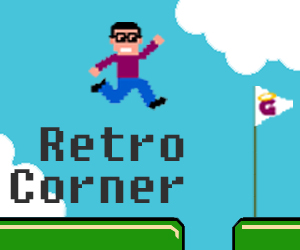 Game: World of Illusion Starring Mickey Mouse and Donald Duck (1992)
Game: World of Illusion Starring Mickey Mouse and Donald Duck (1992)
Developer: SEGA AM7
Publisher: SEGA
Originally Released on: SEGA Megadrive
Currently Available on: Second-hand only: eBay, etc.
Back in the 8 and 16-bit eras of gaming, licensed video game titles weren’t always homogenised across the board. For instance, some games would be platform exclusive, some licenses would be produced by a different developer on each console (such as Jurassic Park on Megadrive and SNES), or sometimes the same developer would have different teams producing wildly different titles on one console and the next; like the 16-bit Alien 3 games from Probe Entertainment.
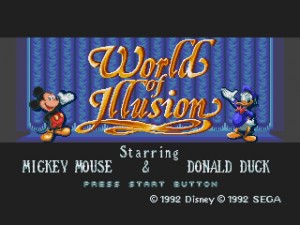 SEGA themselves were responsible for making many of the Megadrive, Master System and Game Gear licensed titles in-house, and this meant that there really was a diverse choice between SEGA and Nintendo consoles when it came to movie spin-offs or cartoon tie-ins. Whilst Capcom and Sony both took over the reigns later in the 16-bit era, SEGA produced some really strong Disney titles that were therefore exclusive to their own platforms. An early hit, and one that helped shift their Master System and Megadrive consoles was Mickey Mouse in Castle of Illusion, a fun platform title, but it was the sequel that really cemented Mickey as a platforming icon for me, as he and Donald Duck teamed up to tackle an even bigger challenge; the World of Illusion.
SEGA themselves were responsible for making many of the Megadrive, Master System and Game Gear licensed titles in-house, and this meant that there really was a diverse choice between SEGA and Nintendo consoles when it came to movie spin-offs or cartoon tie-ins. Whilst Capcom and Sony both took over the reigns later in the 16-bit era, SEGA produced some really strong Disney titles that were therefore exclusive to their own platforms. An early hit, and one that helped shift their Master System and Megadrive consoles was Mickey Mouse in Castle of Illusion, a fun platform title, but it was the sequel that really cemented Mickey as a platforming icon for me, as he and Donald Duck teamed up to tackle an even bigger challenge; the World of Illusion.
 The game begins with the dysfunctional pair practising a magic act that the two of them will be performing together. Looking out for a new trick, and something to wow the audiences, they stumble upon a mysterious magic box, and, after falling through, they find themselves trapped in an alternate dimension, by an unknown wizard who appears as a menacing, cloaked figure. From there, players will have to make their way across five different worlds, each with around two or three mini-stages and a boss within them. You will do battle against many enemies, some new, and some who are recognisable from some of the classic Disney movies that came over the years.
The game begins with the dysfunctional pair practising a magic act that the two of them will be performing together. Looking out for a new trick, and something to wow the audiences, they stumble upon a mysterious magic box, and, after falling through, they find themselves trapped in an alternate dimension, by an unknown wizard who appears as a menacing, cloaked figure. From there, players will have to make their way across five different worlds, each with around two or three mini-stages and a boss within them. You will do battle against many enemies, some new, and some who are recognisable from some of the classic Disney movies that came over the years.
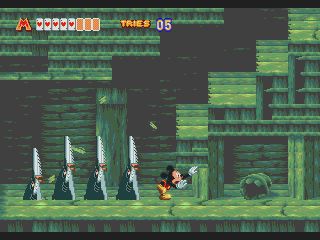 As you encounter all of these bad guys, such as cowboys inspired by the Mad Hatter from Alice in Wonderland, or a very Aladdin-like magic carpet, you won’t fail to notice how rich and beautiful the graphics are. A lot of imagination has gone into working little Disney touches into the environments, and all of the stages are set across several planes, mirroring the multi-plane animation technique that Walt Disney pioneered in the first half of the twentieth century. You might want to stop and admire some of these touches sometimes, but you would probably die or miss a platform by being distracted. Therefore you might want to play through the levels a few times in order to see everything.
As you encounter all of these bad guys, such as cowboys inspired by the Mad Hatter from Alice in Wonderland, or a very Aladdin-like magic carpet, you won’t fail to notice how rich and beautiful the graphics are. A lot of imagination has gone into working little Disney touches into the environments, and all of the stages are set across several planes, mirroring the multi-plane animation technique that Walt Disney pioneered in the first half of the twentieth century. You might want to stop and admire some of these touches sometimes, but you would probably die or miss a platform by being distracted. Therefore you might want to play through the levels a few times in order to see everything.
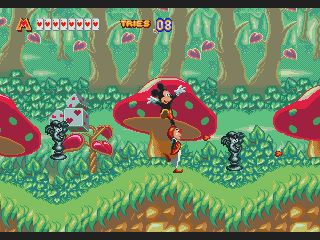 Another touch that adds to the Disney feel is the excellent musical score. The tunes are mostly composed specifically for the game, but they weave some recognisable Disney movie themes into them, and they certainly suit both the action and the mood of the game. They are mysterious, yet fun, tunes that don’t actually get annoying, unlike a lot of other platform games, where once you begin to get frustrated with the gameplay, the music soon becomes really irritating. Perhaps this also has to do with the fact that the game is rather on the easy side, with few levels proving quite challenging (although there are several tricky sections in some levels). The game is also quite short, and you will breeze through the first three worlds in next to no time, and only be left with two to play. Unlike a lot of other games at the time that were tough because you had to play them through in one sitting, the game has a fairly robust password system, and you can always carry on with the game just where you left off, if you need to stop playing.
Another touch that adds to the Disney feel is the excellent musical score. The tunes are mostly composed specifically for the game, but they weave some recognisable Disney movie themes into them, and they certainly suit both the action and the mood of the game. They are mysterious, yet fun, tunes that don’t actually get annoying, unlike a lot of other platform games, where once you begin to get frustrated with the gameplay, the music soon becomes really irritating. Perhaps this also has to do with the fact that the game is rather on the easy side, with few levels proving quite challenging (although there are several tricky sections in some levels). The game is also quite short, and you will breeze through the first three worlds in next to no time, and only be left with two to play. Unlike a lot of other games at the time that were tough because you had to play them through in one sitting, the game has a fairly robust password system, and you can always carry on with the game just where you left off, if you need to stop playing.
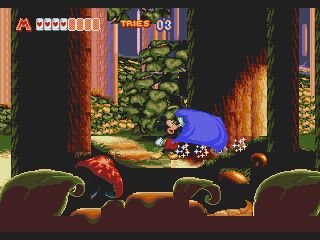 Much like the other Mickey Mouse games that came before it on various SEGA consoles, World of Illusion is a fairly standard platforming game. The gameplay is at once similar and very different than those predecessors. Firstly, what is the same? The controls are simple, with a jump, attack and run button. Most of the levels involve simple platforming, the dispatching of bad guys and some minor puzzles. A new addition for this game is the magic cape that both characters use. Mickey or Donald need only to swish their cape to perform a magic trick. Do this when near an enemy, and the enemy is transformed into something harmless. Do this near certain background elements, and new platforms or objects may appear. You will also learn a magic spell at the end of each level, but these can only be used in specific spots, and the game prompts their use (such as creating a magic carpet to help you navigate a canyon, or a bubble that will allow you to breathe underwater).
Much like the other Mickey Mouse games that came before it on various SEGA consoles, World of Illusion is a fairly standard platforming game. The gameplay is at once similar and very different than those predecessors. Firstly, what is the same? The controls are simple, with a jump, attack and run button. Most of the levels involve simple platforming, the dispatching of bad guys and some minor puzzles. A new addition for this game is the magic cape that both characters use. Mickey or Donald need only to swish their cape to perform a magic trick. Do this when near an enemy, and the enemy is transformed into something harmless. Do this near certain background elements, and new platforms or objects may appear. You will also learn a magic spell at the end of each level, but these can only be used in specific spots, and the game prompts their use (such as creating a magic carpet to help you navigate a canyon, or a bubble that will allow you to breathe underwater).
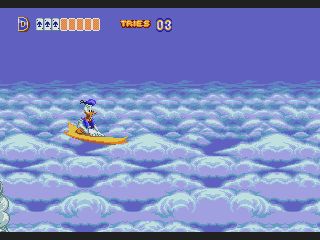 Mickey and Donald actually play quite differently, and this is where the gameplay in the title gets interesting. You can actually have quite a different experience, depending on who you choose to play as. Mickey Mouse has simpler routes through each level, being able to fit through smaller gaps, making traversing tricky parts of the levels a lot easier, and he can jump a little higher; playing as the mouse is akin to an easier difficulty setting. What makes this more evident is the fact that in his quest, you will find a lot more health pick-ups and bonus points than when you take on the game as Donald. Donald Duck does therefore pose more of a challenge, and his larger posterior means he cannot squeeze through tight spaces. You will have to work out different routes around, often ones that are more treacherous than Mickey would face. There are also some timed sequences and you have to be a lot more precise with your jumping. You get the idea that the Donald version of our quest is more like what you can remember about retro platform games; trial, error and some real frustration. Not that it ever gets too much.
Mickey and Donald actually play quite differently, and this is where the gameplay in the title gets interesting. You can actually have quite a different experience, depending on who you choose to play as. Mickey Mouse has simpler routes through each level, being able to fit through smaller gaps, making traversing tricky parts of the levels a lot easier, and he can jump a little higher; playing as the mouse is akin to an easier difficulty setting. What makes this more evident is the fact that in his quest, you will find a lot more health pick-ups and bonus points than when you take on the game as Donald. Donald Duck does therefore pose more of a challenge, and his larger posterior means he cannot squeeze through tight spaces. You will have to work out different routes around, often ones that are more treacherous than Mickey would face. There are also some timed sequences and you have to be a lot more precise with your jumping. You get the idea that the Donald version of our quest is more like what you can remember about retro platform games; trial, error and some real frustration. Not that it ever gets too much.
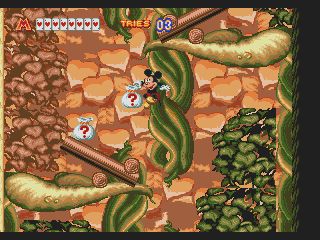 When you choose to play in two player co-operative mode, there are even more new gameplay twists added to the mix. The levels themselves actually have a lot of extra elements added to them, and the layout is even somewhat different. These features include switches where one player will need to stand on the button whilst the other walks through a door and performs a task, for instance. Another instance of this is, whereas in single player there are see-saws that fling you up the screen with the use of a boulder, in co-op, one player must launch the other up using the see-saw, then wait for the other player to lower a rope down to them, so they can climb up to the same point. The fact that Donald can’t fit through tight passages from single-player returns and in co-op, Mickey has to grab his arm and yank him through tight gaps when he gets stuck, in a comical manner. These are nice little touches which certainly force you to have to work together; otherwise you can’t clear a stage. The co-op game will add a lot of life to the game, even after you have finished it in single-player with both of the protagonists. It is a lot of fun playing with a friend, and never gets too frustrating like some platform games can.
When you choose to play in two player co-operative mode, there are even more new gameplay twists added to the mix. The levels themselves actually have a lot of extra elements added to them, and the layout is even somewhat different. These features include switches where one player will need to stand on the button whilst the other walks through a door and performs a task, for instance. Another instance of this is, whereas in single player there are see-saws that fling you up the screen with the use of a boulder, in co-op, one player must launch the other up using the see-saw, then wait for the other player to lower a rope down to them, so they can climb up to the same point. The fact that Donald can’t fit through tight passages from single-player returns and in co-op, Mickey has to grab his arm and yank him through tight gaps when he gets stuck, in a comical manner. These are nice little touches which certainly force you to have to work together; otherwise you can’t clear a stage. The co-op game will add a lot of life to the game, even after you have finished it in single-player with both of the protagonists. It is a lot of fun playing with a friend, and never gets too frustrating like some platform games can.
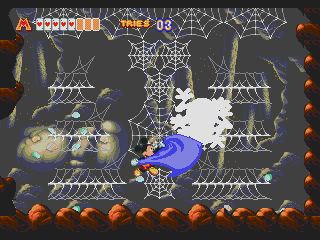 It may be a relatively short title, but the game is rich in detail and little nods to Disney history, and the co-operative aspect adds a lot of replayability to the game. The characters are well-known and likeable ones, and if you are a fan of the House of Mouse, you will get a thrill from some of the in-jokes and Disney references. The game doesn’t suffer from the high frustration levels that a lot of retro games tend to, and can still be played through today for a short burst of fun, family gaming. Why not introduce the title to the new generation of platforming fans? It would be great to see this game on WiiWare, or a similar service.
It may be a relatively short title, but the game is rich in detail and little nods to Disney history, and the co-operative aspect adds a lot of replayability to the game. The characters are well-known and likeable ones, and if you are a fan of the House of Mouse, you will get a thrill from some of the in-jokes and Disney references. The game doesn’t suffer from the high frustration levels that a lot of retro games tend to, and can still be played through today for a short burst of fun, family gaming. Why not introduce the title to the new generation of platforming fans? It would be great to see this game on WiiWare, or a similar service.
World of Illusion only ever came out on the SEGA Megadrive and has yet to be released digitally. You can find the game on Second-hand sites such as eBay. You can see previous entries into the GodisaGeek Retro Corner by clicking here.





